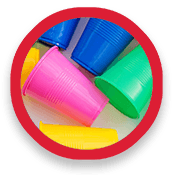SCIENCE EXPERIMENTS FOR KIDS
HOW TO MAKE LAUGHING CUPS
Your kids will get a giggle out of this fun experiment
Everyone has seen a glass crack, but have you heard a cup laugh? Give your child a chuckle with this playful project.
Your little scientist will use simple materials to see and feel sounds! You’ll only need a cup, string and some water for this experiment that will get both your cups and your kids laughing.
GATHER THIS:
- An empty container like a coffee can or yogurt tub
- String
- Push Pin
- Water
- Optional: Toothpick
THEN DO THIS:
- Use the push pin to poke a hole in the center of the bottom of the container.
- Cut a few feet of string.
- Push the string through the hole in the container.
- Tie a knot in the string on the end inside the container so you cannot pull the string out the bottom. Another way would be to tie a toothpick to the string inside the container.
- Hold the container upright in one hand and dampen the other hand with water.
- Hold the string with your wet hand, and pull down, letting the string slide through your grip.
- Try making Laughing Cups out of different containers and see, hear, and feel what happens.
ASK THIS:
- What happens if you grip the string tighter or looser?
- What happens if you grip the string near the container or farther from it?
- What would happen if you used a string twice as long?
- What if you made a Laughing Cup out of a bigger or smaller container?
- Why does the container vibrate when you slide your hand along the string?
- What do you see happening to the string when the container makes sound?
WHAT IS HAPPENING?
Sliding your fingers on the damp string creates a vibration in the string, which vibrates the container, which vibrates the air in contact with the container. The vibration travels through the air. When the air near us vibrates, it causes our eardrums to vibrate, and inside our eardrums are three tiny bones that vibrate. The vibrations of those bones are transmitted through a fluid in our cochlea, where different types of vibrations (different frequencies) interact with tiny hair-like cells which send the information to our brains.
WHAT THIS TEACHES:
Skills: Sound, motor skills, experimental design process
Themes: Sound, vibrations and energy
Join the CuriOdyssey Community
LOCATION
1651 Coyote Point Drive
San Mateo, CA 94401
Ohlone Land Acknowledgement
650-342-7755
info@curiodyssey.org
CuriOdyssey is a 501(c)(3) non-profit, Tax ID 94-1262434




